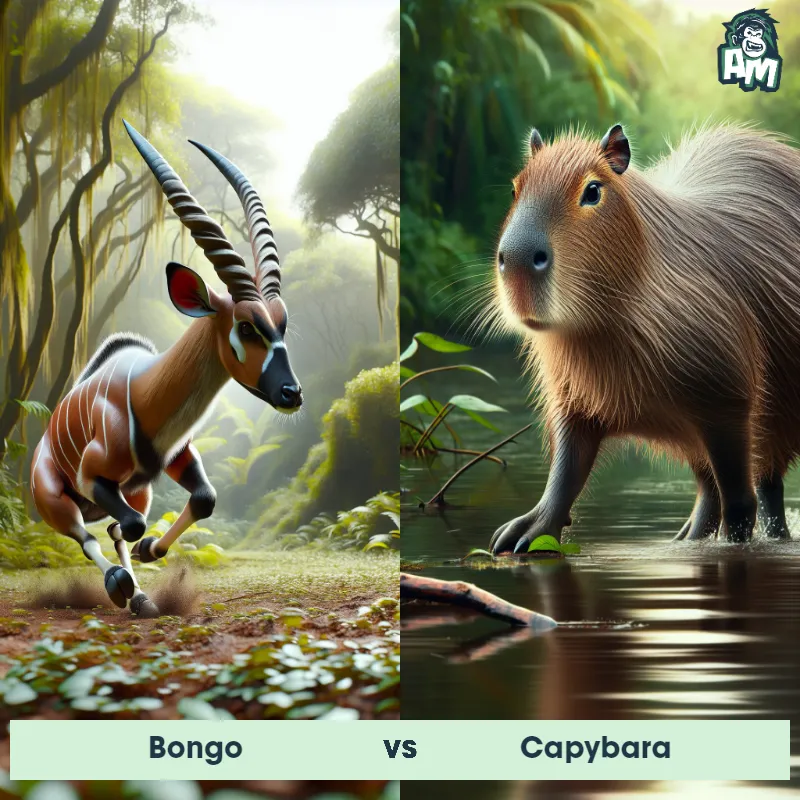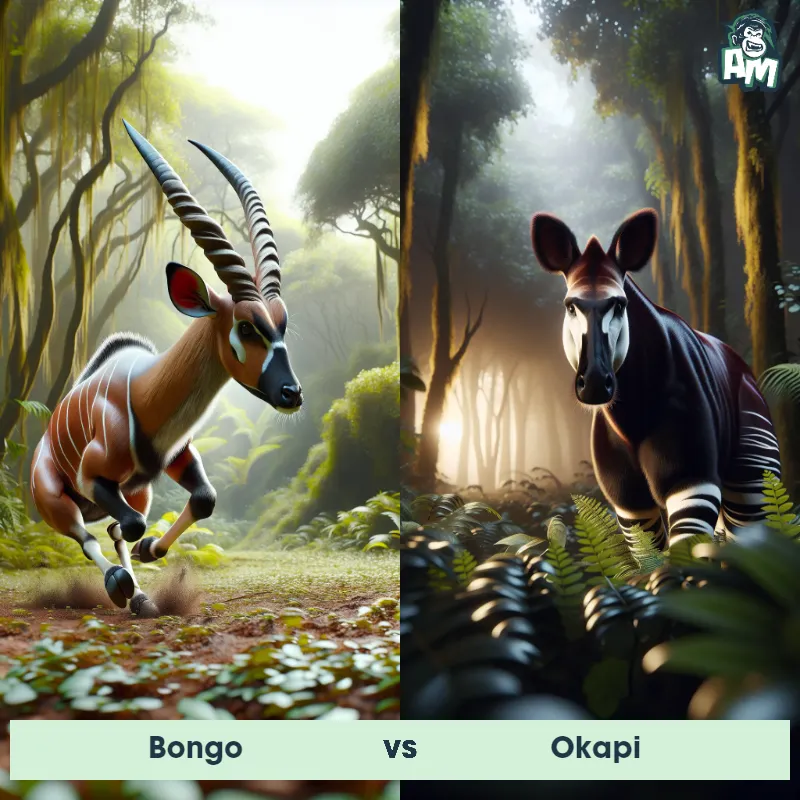The Bongo
The Bongo, also known as the Eastern or Mountain Bongo, is a large and striking antelope species found in the mountainous forests of East Africa. They have a reddish-brown coat with vertical white stripes running down their body, providing excellent camouflage in their dense forest habitat. Bongos have long and slightly spiraled horns, prominent ears, and a distinctive hump on their shoulders. They are the largest forest-dwelling antelope, with males weighing up to 900 lbs and standing over 4 feet at the shoulder.

| Bongo | |
|---|---|
| Size | Around 4.5 feet (1.4 meters) |
| Weight | Up to 900 pounds (408 kilograms) |
| Speed | 81mph (130km/h) |
| Key Strength | Unknown (data not provided) |
| Biggest Weakness | Unknown (data not provided) |
| Scientific Name | Tragelaphus eurycerus |
| Family | Bovidae |
| Habitat | Tropical forests |
| Geography | Central and Eastern Africa |
| Diet | Herbivorous |
| Lifespan | 10 years - 15 years |

The Bongo
The Bongo, also known as the Eastern or Mountain Bongo, is a large and striking antelope species found in the mountainous forests of East Africa. They have a reddish-brown coat with vertical white stripes running down their body, providing excellent camouflage in their dense forest habitat. Bongos have long and slightly spiraled horns, prominent ears, and a distinctive hump on their shoulders. They are the largest forest-dwelling antelope, with males weighing up to 900 lbs and standing over 4 feet at the shoulder.
Fun Fact: The Bongo is known for its exceptional ability to navigate dense forests, as their unique legs and hooves allow them to move silently and gracefully through the undergrowth, making them nearly undetectable!
| Bongo | |
|---|---|
| Size | Around 4.5 feet (1.4 meters) |
| Weight | Up to 900 pounds (408 kilograms) |
| Speed | 81mph (130km/h) |
| Key Strength | Unknown (data not provided) |
| Biggest Weakness | Unknown (data not provided) |
| Scientific Name | Tragelaphus eurycerus |
| Family | Bovidae |
| Habitat | Tropical forests |
| Geography | Central and Eastern Africa |
| Diet | Herbivorous |
| Lifespan | 10 years - 15 years |
Bongo Matchups
We use AI to simulate matchups between the Bongo and other animals. Our simulation considers size, strength, and natural predatory behaviors to determine the most likely outcome.
Bongo: Diet, Predators, Aggression, and Defensive Behaviors
What do Bongos eat?
Bongos are herbivores and mainly feed on leaves, grasses, bushes, and fruits. They have a specialized diet that includes a variety of vegetation found in their natural habitat, such as browse from trees and shrubs.
Do Bongos have any predators?
Bongos do have predators in the wild, including large carnivores like lions, leopards, and hyenas. They are also vulnerable to hunting by humans for their meat and horns, further contributing to their declining population in the wild.
Are Bongos aggressive?
Bongos are not typically aggressive animals. They are known to be shy and elusive, preferring to avoid confrontation with potential threats. However, they may become defensive if they feel threatened or cornered.
Do Bongos fight?
Bongos are not known to engage in aggressive encounters with each other or other species. They are more likely to flee or hide when faced with danger, using their keen sense of hearing and sight to detect threats before engaging in any physical conflicts.
How do Bongos defend themselves?
Bongos have several defense mechanisms to protect themselves from predators. They are known for their ability to camouflage in dense vegetation, making it difficult for predators to spot them. Additionally, they can run at high speeds and maneuver through thick forests to escape danger.
What is Bongos' biggest weakness in a fight?
Despite their agility and speed, Bongos are at a disadvantage when it comes to physical confrontations with predators like lions or leopards. Their large size and horns may offer some protection, but they are not equipped to deal with powerful carnivores in a direct confrontation. This makes them vulnerable to attacks from larger, stronger predators in their natural habitat.
Fun Fact: One fascinating aspect of the Bongo is that both males and females possess horns, which is quite rare among antelope species. The female bongos' horns are usually longer and thinner than those of males.
Fun Fact: Bongos are extremely shy and elusive animals, opting to avoid confrontations by vanishing into dense vegetation. They rely on their secretive nature and excellent camouflage to blend seamlessly with their surroundings, making them challenging to spot in the wild.













